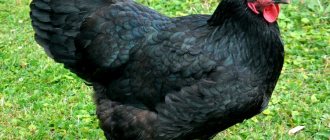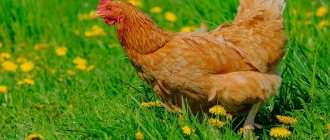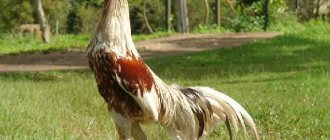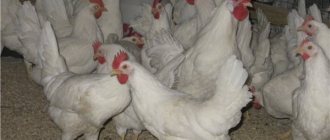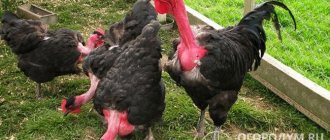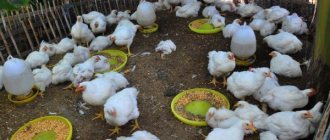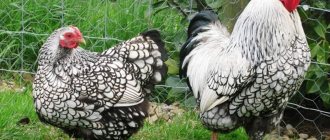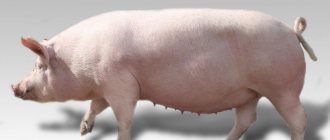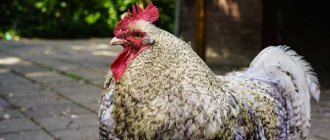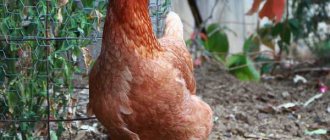Owners of private farms from Russia prefer to breed domestically selected chickens, as they are well adapted to the local climate and require little care. For many poultry farmers, the Leningrad white breed of chickens for meat and egg production has become a favorite. Farmers who have had the opportunity to keep these birds leave positive reviews about them, emphasizing the advantages of birds - high growth rates of young animals, excellent taste of meat, good egg production and unpretentiousness.
Leningrad chickens
History of selection
The description of the Leningrad White breed contains information about its origin. The line was created at the Leningrad All-Union Scientific Research Institute based on Leghorn hens with white plumage. They were crossed with Australorps, meat chickens, to ultimately produce a meat-and-egg breed. The best descendants were selected from three generations, then the traits were fixed by breeding within the line.
Scientists achieved their goal a few years later - they created a large, tall laying hen that is not afraid of the cold, is not subject to stress and is undemanding in terms of housing conditions and feed. The bird inherited good egg production and snow-white color from Leghorns. Australorps gave her their best qualities - the ability to grow rapidly, the excellent taste of meat, and the marketability of carcasses.
Description of the Leningrad White chicken breed
The Leningrad white chicken shown in the photo has strong bones and a massive body. The weight of an adult rooster can reach 4 kg. Laying hens are 1 kg lighter. The plumage is pure white, thick and dense. The color is not allowed to contain any other shades of feathers.
Rooster of the Leningrad white breed
Exterior of a bird
Exterior characteristics of the Leningrad White chicken breed:
- a medium-sized head with a well-developed leaf-shaped red crest;
- earrings are oval, earlobes are red and white;
- the iris of the eyes is bright orange;
- yellow beak;
- massive neck;
- the back is wide;
- the chest is full;
- the wings are well developed, but due to their weight the birds cannot fly high;
- limbs are strong with a wide stance;
- the metatarsals are yellow with large dark spots on the toes.
Productivity
Chickens of the Leningrad white breed weigh about 3.5 kg. Bird carcasses have a good presentation - the skin is light yellow, the breast, thighs and legs are fleshy. The meat is soft, sweetish, with a pleasant aroma. The product is used for boiling, stewing, frying and baking.
Attention! Chickens of this breed grow quickly. At the age of 2 months, their weight reaches 1.2–1.5 kg.
Hens begin to lay eggs at 6 months. During the first year of laying, the pullet produces 180–190 eggs. Further productivity decreases slightly. The weight of a product unit is 60 g, the shell is colored light brown.
Leningrad layer eggs
Character of birds
White Leningrad chickens are friendly and peaceful. The leader of the pack is ready to protect his family members, but he cannot be called cocky. Laying hens behave calmly. The birds are not shy, they quickly get used to the new environment and owner.
Hatching instinct
Leningrad laying hens have a developed maternal instinct. Chickens willingly hatch chicks, and when they are born, they take care of the offspring. Kvochki warm the babies, protect them, and accustom them to the feeder.
Diseases
There are no diseases that would be inherent in Leningrad white chickens. But if they are not properly cared for, their immunity decreases, and then they can become infected with any disease from other birds with whom they come into contact.
- Parasites
- Infectious
- Other
Chicken mite
How to treat a chicken coop and how to treat a bird. Description of drugs and methods of control
Read
Coccidiosis
Thirst, loss of appetite, swelling, bloody droppings, anemia, weakness, poor coordination
Read
Ascariasis
Loss of appetite, liquid droppings, pale mucous membranes of the comb, limbs, ruffled plumage, lethargy, vomiting
Read
Amidostomiasis
Symptoms of the acute form: apathy, general weakness, decreased or lack of appetite, breathing problems, unsteady gait, retarded growth and development
Read
Prostagonymosis
Decreased mobility, loss of appetite, unsteady gait, bloating, fever, impaired egg laying, exhaustion
Read
Knemidocoptic mange (“lime foot”)
Acute symptoms: light gray bumps appear on the legs, the bird limps and stands on one leg, the cloaca and joints become inflamed, the beak is deformed
Read
Heteracidosis
Symptoms: indigestion, diarrhea, loss of appetite, lethargy, decreased egg production, retarded growth and development
Read
Trichomoniasis
Symptoms of the acute form: fever, depression and loss of appetite, diarrhea with gas bubbles and a putrid odor, enlarged goiter, difficulty breathing and swallowing
Read
Pullorosis (typhoid fever, salmonellosis)
Weakness, lack of coordination, drooping eyelids, difficulty breathing, lack of appetite, indigestion
Read
Colibacillosis
Lack of appetite, thirst, sudden increase in temperature, pale scallops, diarrhea
Read
Pasteurellosis
Fever, foamy mucus, change in stool color, refusal to feed, thirst, lethargy, wheezing, heavy breathing
Read
Marek's disease
Paralysis of the limbs, difficulty breathing, severe exhaustion and loss of strength, refusal of food and water, pallor of the scallop
Read
Gumboro disease
Diarrhea, loss of appetite, trembling legs and head, sudden death
Read
Laryngotracheitis
Weakness, swelling of the neck, difficulty breathing, cough, wheezing, blood clots in the mucus released when coughing, lack of appetite, indigestion
Read
Bird flu
Refusal to eat, anorexia, diarrhea, purulent discharge, hoarse breathing, greenish-brown droppings, seizures, darkening of the ridge
Read
Newcastle disease
Decreased appetite, fever, respiratory distress, immobility, conjunctivitis, bloody diarrhea
Read
Apteriosis
Complete or partial absence of plumage, loss of tail feathers, broken embryonic fuzz in young animals, delayed growth of plumage, pecking
Read
Pterophagy
Plucking and eating feathers. What is the reason, why does it require urgent intervention and how to prevent the disease?
Read
Yolk peritonitis
Symptoms of the acute form: loss of appetite, gray-green color of feces, sudden drop in egg production, calcareous deposits on the shell, bluish tint and baldness of the abdominal skin
Read
Cloacite
Symptoms: depressed state, decreased appetite, weight loss, increased need for water, loss of plumage, inflammation and bulging of the cloaca, the presence of ulcers on the mucous membrane, decreased egg production
Read
Advantages and disadvantages of the breed
Owners of small farms believe that Leningrad white chickens are ideal for home breeding. Laying hens are valued for the following qualities:
- high meat and egg productivity;
- friendly disposition;
- adaptability to the climate of the middle zone;
- presence of maternal instinct;
- unpretentiousness to living conditions and feed;
- beautiful appearance.
The disadvantages of the breed include the low survival rate of adult livestock, it is equal to 80%. From this we can conclude that representatives of this breed have weak immunity. Those who raise poultry will have to pay more attention to disease prevention. The safety of young animals is at an acceptable level - 93%.
Basic bird care
Despite its representative appearance, growing Leningradskaya White is very simple. Animals are not very whimsical, both to their habitat and to the food itself. Two main facts you need to know about a chicken coop for this breed: first, the room should always be dry. Secondly, you need to avoid strong drafts inside the chicken coop. The Leningrad White was endowed with a very strong immune system and is indifferent to those diseases that could kill other birds. There are also no problems with food. The main thing is to give the birds the amount of food they need. This means that a specific diet is needed so that the Leningrad White is not skinny or overweight, in both cases, this can affect the level of egg production of the hen.
Features of keeping birds
Chickens of the Leningrad breed are undemanding to living conditions. They will only need a cozy home and a walking area. In order for laying hens to provide their owner with a large number of eggs and quickly increase weight gain, they need to be well fed.
How to set up a chicken coop: tips
The health and productivity of a bird largely depends on the conditions in which it lives. Leningrad White chickens can be kept in an unheated chicken coop. The main thing is that the room temperature in winter does not fall below +10 ºС. The walls, roof and floor need to be insulated. It is convenient to use infrared lamps as sources of heat and light.
Infrared lamp for chicken coop
It is important to provide ventilation in the poultry house - stale air containing ammonia vapor must be removed from the room. The recommended humidity level in the barn is 60-70%. To preserve heat, 15–20 cm of sawdust with the addition of peat should be laid on the floor. To keep the surface dry and clean, the litter needs to be turned about once a week. The top layer of sawdust is renewed monthly.
Chickens sleep on the roost. It is better to install them at a height of 60–80 cm, equipped with comfortable flat ladders, since Leningrad laying hens are clumsy and do not fly well. For every 4–5 individuals, nest boxes covered with straw are installed. They are placed in a darkened corner of the poultry house, protected from drafts.
A feeder, a container with gravel, a bowl with a shell and a drinking bowl are placed on the floor. Birds will need an ash bath for bathing. You can use a trough or a large basin. Sand and ash are poured into it. While wallowing in this mixture, the chickens cleanse their feathers of skin parasites.
Walk
A walking area is set up next to the chicken coop. It is useful for birds to be in the fresh air in winter and summer. Walking helps strengthen the immune system and has a beneficial effect on the quality of meat. Each bird is allocated 1–1.5 m of free space. Representatives of the Leningrad breed do not need a high fence; 1.2–1.5 m is enough. A canopy is installed to protect them from rain.
Chickens need to be walked
In summer, birds walk all day long. In winter, they are released for an hour and a half at lunchtime, when the air warms up. While the chickens are on the run, the door to the chicken coop is kept open to ensure the room is well ventilated.
Attention! Walking too long in the cold is prohibited - birds can get frostbite on their combs.
Nutrition
A properly formulated diet for birds is the key to their health and high productivity. Leningrad white chickens are undemanding when it comes to food supply - they eat everything that the owner gives, be it mixed feed or mash prepared with their own hands. The main part of the diet is a grain mixture rich in protein. Vegetables and herbs are sources of vitamins and microelements. In winter, the menu for laying hens includes grass pellets and sprouted wheat.
Sprouted wheat is beneficial for laying hens
Birds should receive mineral supplements. These are chalk, bone meal, fish meal, shell rock, eggshell. Young animals are given fish oil to prevent rickets. During the molting period, laying hens are given vitamins to strengthen the immune system.
Attention! It is important to distribute food at the same time, without leaving long intervals between feedings. When very hungry, chickens pounce on food and stuff the crop tightly, which often causes blockage. To avoid digestive problems, chickens should have access to gravel. Small pebbles help process rough food.
The frequency of feeding depends on the season. In summer, food is distributed in the morning and evening, since in the middle of the day the livestock independently obtains its own food on the street. In winter, chickens have three meals a day - for lunch they are given wet mash. The feeders are filled so that the birds eat the entire contents in 30–40 minutes. Overfeeding birds leads to obesity and decreased egg production.
Breeding chickens on a home farm
There are no problems with breeding Leningrad white chickens. When selecting birds for a tribe, individuals are left without defects in appearance and with high productivity indicators. For every 10 laying hens there is 1 rooster. A hen is used to raise chickens in villages.
The hen needs to be given a cozy place in the corner, and a separate feeder and drinking bowl should be placed next to the nest. The hen sits on the eggs for 21 days, then the chicks hatch. After birth, babies weigh no more than 40 g, they are covered with light yellow soft down. Real feathers appear gradually. Some farmers raise the chicks in a brooder, while others let the hen care for the chicks.
Leningrad chicken chickens
At first the chicks are fed every 2 hours. On day 4 they are switched to five meals a day. From two weeks of age, young animals eat 4 times a day. The chicks' first food is a boiled egg. The diet is gradually expanded to include steamed millet, green onions, low-fat cottage cheese, grated carrots, and corn chaff. Young animals can eat whole grain food from the age of one month.
Incubation
Chicks can be raised in an incubator. No special conditions are required for this.
Table of temperature and humidity modes
| Period |
